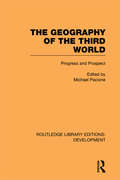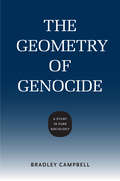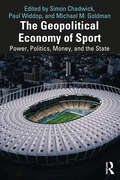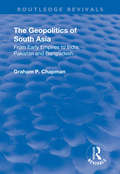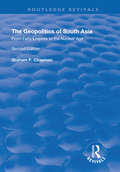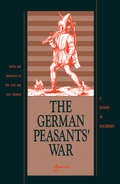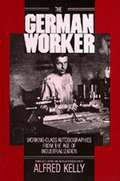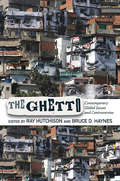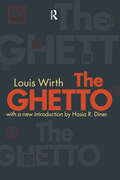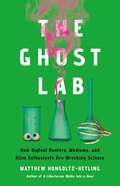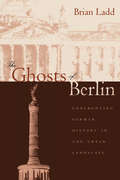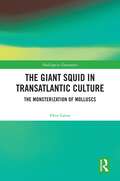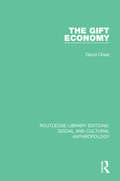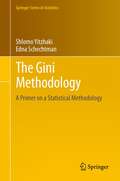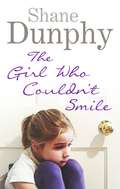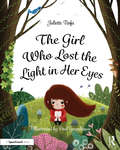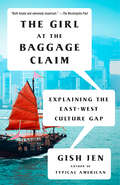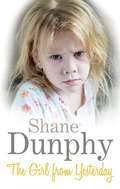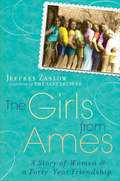- Table View
- List View
The Geography of the Third World: Progress and Prospect (Routledge Library Editions: Development)
by Michael PacioneFirst published in 1988, this reissue presents a comprehensive overview of contemporary developments and research into the geography of the Third World, at a time when economies and societies there were changing at a much more rapid rate than their counterparts in the developing world. It covers the topic both systematically and by region, showing how the unique background of each region affects developments there.
The Geometry of Genocide: A Study in Pure Sociology (Studies in Pure Sociology)
by Bradley CampbellIn The Geometry of Genocide, Bradley Campbell argues that genocide is best understood not as deviant behavior but as social control--a response to perceived deviant behavior on the part of victims. Using Donald Black's method of pure sociology, Campbell considers genocide in relation to three features of social life: diversity, inequality, and intimacy. According to this theory, genocidal conflicts begin with changes in diversity and inequality, such as when two previously separated ethnic groups come into contact, or when a subordinate ethnic group attempts to rise in status. Further, conflicts are more likely to result in genocide when they occur in a context of social distance and inequality and when aggressors and victims cannot be easily separated. Campbell applies his approach to five cases: the killings of American Indians in 1850s California, Muslims in 2002 India and 1992 Bosnia, Tutsis in 1994 Rwanda, and Jews in 1940s Europe. These case studies, which focus in detail on particular incidents within each instance of genocide, demonstrate the theory's ability to explain an array of factors, including why genocide occurs and who participates. Campbell's theory uniquely connects the study of genocide to the larger study of conflict and social control. By situating genocide among these broader phenomena, The Geometry of Genocide provides a novel and compelling explanation of genocide, while furthering our understanding of why humans have conflicts and why they respond to conflict as they do.
The Geopolitical Economy of Sport: Power, Politics, Money, and the State
by Simon Chadwick, Paul Widdop, and Michael M. GoldmanThis is the first book to define and explore the geopolitical economy of sport – the intersection of power, politics, money, and state interests that both exploit and shape elite sport around the world. Russia’s invasion of Ukraine, the global response, and the consequent ramifications for sport have put the geopolitical economy of sport front and centre in both public debate and academic thinking. Similarly, the Winter Olympics in Beijing and the FIFA World Cup in Qatar illustrate the political, economic, and geographic imperatives that shape modern sport. This book brings together studies from around the world to describe this new geopolitical economy of sport, from the way in which countries use natural resource revenues, accusations of sport washing, and the deployment of sport for soft power purposes, to the way in which sport has become a focus for industrial development. This book looks at the geopolitical economy of sport across the globe, from the Gulf States’ interests in European soccer to Israel seeking to build a national competitive advantage by positioning itself as a global sports tech start-up hub, and the United States continuing to extend its economic and cultural influence through geopolitical sport activities in Africa, Latin America, and the Indian subcontinent. This book captures a pivotal moment in the history of sport and sport business. This is essential reading for any student, researcher, practitioner, or policymaker with an interest in sport business, the politics of sport, geopolitics, soft power, diplomacy, international relations, or international political economy.
The Geopolitics of South Asia: From Early Empires to India, Pakistan and Bangladesh (Routledge Revivals)
by Graham P. ChapmanThis title was first published in 2000: This volume explores one of the world's greatest cultural heartlands - the Indian sub-continent. It shows how geological movements moulded the land and how they still impact upon it; how the culture of early setters evolved to form Hinduism; how its wealth and power attracted the attention of Islamic invaders who founded the Sultanate of Delhi and then the great Mogul Empire; and how they were later usurped by the British Raj. The story continues with the trauma of Partition and Independence in 1947, as India's unique form of Islam shook free from Nehru's secular India with the founding of Pakistan. At different points in the story, discussions are woven in on subjects such as caste or the management of water resources. Much of the book is written in terms of the three major forces of integration.These are "identitive" forces - bonds of language, ethnicity, religion or ideology; "utilitarian" forces - bonds of common material interests; and "coercion" - the institutional use or threat of physical violence. By studying these forces, Professor Chapman shows how the organization of territory - as states and empires, as monarchic realms and as representative democracies - has been central to the region's historic, cultural, linguistic and economic development. In doing so, he contends that the lynchpin of this region's story is a geopolitical one.
The Geopolitics of South Asia: From Early Empires to the Nuclear Age (Routledge Revivals Ser.)
by Graham ChapmanAnyone who is planning on carrying out research in South Asia or indeed anyone who simply wishes to understand more about this cultural heartland should read this book. It shows how geological movements moulded the land of this unique cradle and how they still impact on it. Discussions are woven around the three major forces of integration. These are 'identitive' forces - bonds of language, ethnicity, religion or ideology; 'utilitarian' forces - bonds of common material interest, and 'coercion' - the institutional use or threat of physical violence. By studying these forces, Professor Chapman shows how the organization of territory has been central to the region's historic, cultural, linguistic and economic development. In addition to the material on the Northwest frontier, Afghanistan and Kashmir which was added for the second edition, the Northeastern borderlands are also now examined in this fully revised third edition. The current geopolitical state of the region is completely updated and greatly enhanced.
The German Wall
by Marc SilbermanThis interdisciplinary volume addresses the consequences of the fall of the Berlin Wall, from the revitalizing effect it had on Germany to the new challenges of integrating socially and politically old and new minorities, and forming a new European identity. It also considers how the fall was represented by the media.
The German Worker: Working-Class Autobiographies from the Age of Industrialization
by Alfred H. KellyIn the two generations before World War I, Germany emerged as Europe's foremost industrial power. The basic facts of increasing industrial output, lengthening railroad lines, urbanization, and rising exports are well known. Behind those facts, in the historical shadows, stand millions of anonymous men and women: the workers who actually put down the railroad ties, hacked out the coal, sewed the shirt collars, printed the books, or carried the bricks that made Germany a great nation. This book contains translated selections from the autobiographies of nineteen of those now-forgotten millions. The thirteen men and six women who speak from these pages afford an intimate firsthand look at how massive social and economic changes are reflected on a personal level in the everyday lives of workers.
The Ghetto
by Bruce D. Haynes Ray HutchisonToo often the term "ghetto" is simply applied to any African American community, to the inner city as a whole, or recently to anything that is degraded or unrefined. But what is a ghetto? Does it arise organically from cities, or is it a consequence of social conflict and government policy? Are the banlieues, barrios, favelas, shantytowns, and slums of Europe, South America, and other continents similar to the American ghetto?The Ghetto invites us to reexamine our assumptions by addressing these and other critical questions. Concise, original essays from top scholars around the world clearly describe essential arguments and discoveries, making the current discussion of marginalized urban spaces accessible for all readers and students of urban studies and sociology.
The Ghetto
by Bruce D. Haynes Ray HutchisonToo often the term "ghetto” is simply applied to any African American community, to the inner city as a whole, or recently to anything that is degraded or unrefined. But what is a ghetto? Does it arise organically from cities, or is it a consequence of social conflict and government policy? Are the banlieues, barrios, favelas, shantytowns, and slums of Europe, South America, and other continents similar to the American ghetto? The Ghetto invites us to reexamine our assumptions by addressing these and other critical questions. Concise, original essays from top scholars around the world clearly describe essential arguments and discoveries, making the current discussion of marginalized urban spaces accessible for all readers and students of urban studies and sociology.
The Ghetto
by Louis WirthWhen The Ghetto first appeared seventy years ago, Bruno Lasker in the New York Times called it "the most informing general account of the cultural background and psychological development of the American Jew." Arguably, the book still occupies this special niche in ethnic studies. Hasia Diner's extensive new introduction, in itself an important contribution to the history of sociological ideas, points out that The Ghetto "stands in a class by itself as a piece of scholarship of the early twentieth century." That judgment stands.The Ghetto traces back to the medieval era the Jewish immigrant colonies that have virtually disappeared from our modern cities—to be replaced by other ghettoes. Analytical as well as historical, Wirth's book lays bare the rich inner life hidden behind the drab exterior of the ghetto. The book describes the significant physical, social, and psychic influences of ghetto life upon the Jews. Wirth demonstrates that the economic life of the modern Jew still reflects the impress of the social isolation of ghetto life; at first self-imposed, later formalized, and finally imposed by others through a variety of extralegal mechanisms. He presents a faithful picture of an environment now largely vanished and illustrates a sociological method in so doing.In his foreword to the book, Robert E. Park reminds us that the city is not merely an artifact but an organism. Its growth is often uncontrolled and undesigned. The forms it tends to assume are those which represent and correspond to the functions that it is called upon to perform. The Ghetto will be important to scholars in Jewish studies, the history of sociology, American ethnic history, and social history. This volume is the second in a series of studies in ethnicity edited by Ronald H. Bayor of the Georgia Institute of Technology.
The Ghost Lab: How Bigfoot Hunters, Mediums, and Alien Enthusiasts Are Wrecking Science
by Matthew Hongoltz-HetlingA surprising and compelling journey into the business of paranormal investigation, and the state of scientific literacy in America. In 2010, a sleepy small-town business plaza in rural New Hampshire rented space to an unusual tenant: a ghost laboratory. The Kitt Research Initiative&’s mission was to use the scientific method to document the existence of spirits. Founder Andy Kitt was known as a straight-shooter; and was unafraid — perhaps eager — to offend other paranormal investigators by exposing the fraudulence of their less advanced techniques. Kitt&’s efforts attracted flocks of psychics, alien abductees, witches, mediums, ghost hunters, UFOlogists, cryptozoologists and warlocks from all over New England, and the world. And there were plenty of them around.The Ghost Lab tells the astonishing story of the wild ecosystem of paranormal profiteers and consumers. But it also reveals how the twin scourges of declining scientific literacy and eroding trust in institutions have created space for armies of pseudoscientists to step into the minds of an increasingly credulous public. With his distinct voice, eye for a story and ability to show how one community's experience reflects that of a society, Matt Hongoltz-Hetling crafts a powerful narrative about just how fragmented our understanding of what is real--and what is not--has become.
The Ghosts of Berlin: Confronting German History in the Urban Landscape
by Brian LaddIn this compelling work, Brian Ladd examines the ongoing conflicts radiating from the remarkable fusion of architecture, history, and national identity in Berlin. Ladd surveys the urban landscape, excavating its ruins, contemplating its buildings and memorials, and carefully deconstructing the public debates and political controversies emerging from its past. "Written in a clear and elegant style, The Ghosts of Berlin is not just another colorless architectural history of the German capital. . . . Mr. Ladd's book is a superb guide to this process of urban self-definition, both past and present. "--Katharina Thote, Wall Street Journal "If a book can have the power to change a public debate, then The Ghosts of Berlin is such a book. Among the many new books about Berlin that I have read, Brian Ladd's is certainly the most impressive. . . . Ladd's approach also owes its success to the fact that he is a good storyteller. His history of Berlin's architectural successes and failures reads entertainingly like a detective novel. "--Peter Schneider, New Republic "[Ladd's] well-written and well-illustrated book amounts to a brief history of the city as well as a guide to its landscape. "--Anthony Grafton, New York Review of Books
The Giant Squid in Transatlantic Culture: The Monsterization of Molluscs (Multispecies Encounters)
by Otto LatvaThis book builds upon the extensive study of the historical relationship between sea animals and humans in transatlantic culture during the eighteenth and nineteenth centuries. It exposes the present understanding of the human relationship with the giant squid not only as too simplistic but also as historically inaccurate. For instance, it redefines the earlier understanding that humans and especially seafarers have understood giant squid as horror-evoking and ugly creatures since the dawn of history and explains the origins of mythical sea monsters such as the Kraken. The book is, however, more than a critical response to previous work. It will point out that animals such as cephalopods, which have largely been defined in biological contexts in recent times, have a fascinating and multivariate past, entangled with the history of humans in many remarkable ways. Hence, this book is not just about perceptions of giant-sized squid or cephalopods, but a historical inquiry into the transatlantic culture from the late eighteenth century to the turn of the twentieth century. It will provide new knowledge about the history of mollusc studies, seafaring culture and more broadly of the relationship between humans and animals during the period.
The Gift Economy (Routledge Library Editions: Social and Cultural Anthropology)
by David ChealUntil recently we have known more about gift giving practices in pre-industrial societies than about those of industrial western society. In this book, first published in 1988, David Cheal shows that the process of present giving and receiving is a vital element in contemporary social life, relevant to some of the most important theoretical traditions in sociology, particularly those of Durkheim and Weber, and to the social constructionism of Peter Berger and Thomas Luckmann. This volume is the result of a major study of gift rituals carried out by David Cheal and his associates in which general themes are richly illustrated with details from individual case histories gathered during the research. It is highly significant that in western society women are more active gift givers than men and, while their voices explain how emotions and interests are interrelated within the gift economy, the author shows how that in turn is related to current theories about family, gender and religion.
The Gift of European Thought and the Cost of Living
by Vassos ArgyrouEuropean thought is often said to be a gift to the rest of the world, but what if there is no gift as such? What if there is only an economy where every giving is also a taking, and every taking is also a giving? This book extends the question of economies by making a case for an "economy of thought" and a "political economy." It argues that all thinking and doing presupposes taking, and therefore giving, as the price to pay for taking; or that there exists a "cost of living," which renders the idea of free thinking and living untenable. The argument is developed against the Enlightenment directive to think for oneself as the means of becoming autonomous and shows that this "light," given to the rest of the world as a gift, turns out to be nothing.
The Gift: The Form and Reason for Exchange in Archaic Societies
by Marcel Mauss W. D. HallsThe gift is a perfect example of what Mauss calls a total social phenomenon, since it involves legal, economic, moral, religious, aesthetic, and other dimensions. He sees the gift exchange as related to individuals and groups as much as to the objects themselves, and his analysis calls into question the social conventions and economic systems that had been taken for granted for so many years. In a modern translation, introduced by distinguished anthropologist Mary Douglas, The Gift is essential reading for students of social anthropology and sociology.
The Gini Methodology
by Shlomo Yitzhaki Edna SchechtmanGini's mean difference (GMD) was first introduced by Corrado Gini in 1912 as an alternative measure of variability. GMD and the parameters which are derived from it (such as the Gini coefficient or the concentration ratio) have been in use in the area of income distribution for almost a century. In practice, the use of GMD as a measure of variability is justified whenever the investigator is not ready to impose, without questioning, the convenient world of normality. This makes the GMD of critical importance in the complex research of statisticians, economists, econometricians, and policy makers. This book focuses on imitating analyses that are based on variance by replacing variance with the GMD and its variants. In this way, the text showcases how almost everything that can be done with the variance as a measure of variability, can be replicated by using Gini. Beyond this, there are marked benefits to utilizing Gini as opposed to other methods. One of the advantages of using Gini methodology is that it provides a unified system that enables the user to learn about various aspects of the underlying distribution. It also provides a systematic method and a unified terminology. Using Gini methodology can reduce the risk of imposing assumptions that are not supported by the data on the model. With these benefits in mind the text uses the covariance-based approach, though applications to other approaches are mentioned as well.
The Girl Who Couldn't Smile
by Shane DunphyWhen Shane Dunphy starts work at Little Scamps crèche, he has no idea what he has let himself in for. He had not worked in an early years setting for many years and on arriving for his first day he found that two members of staff, Susan and Tush, are at the end of their tether and on the verge of resigning. The children themselves are completely out of control. At the centre of this chaos Shane finds Tammy, a pretty, doll-like five-year-old who is a mystery to everyone: she does not talk, or even smile, yet shows signs of remarkable intelligence.Through the course of the year, Shane attempts to bring order to this motley group and we learn the stories of some of the other children in the crèche: Milandra, an angry, violent four year old, the daughter of a Nigerian father and Irish mother; Rufus, a gypsy child who is direly neglected; Julie, a tiny, painfully shy little girl with Down's Syndrome. How is Shane ever to find a way to communicate with and ultimately befriend such diverse and challenging personalities? Then one afternoon, Gus, the class tear away, receives the gift of a blue crayon - a crayon he claims is magic. And Shane begins to wonder if this magic could be the answer to all his problems ... Shane Dunphy's moving portrait of a year at Little Scamps is a testament to the redemptive power of love and nurturing, of finding oneself through the care of others, as well as finding the secret of a girl who couldn't smile.
The Girl Who Couldn't Smile
by Shane DunphyWhen Shane Dunphy starts work at Little Scamps crèche, he has no idea what he has let himself in for. He had not worked in an early years setting for many years and on arriving for his first day he found that two members of staff, Susan and Tush, are at the end of their tether and on the verge of resigning. The children themselves are completely out of control. At the centre of this chaos Shane finds Tammy, a pretty, doll-like five-year-old who is a mystery to everyone: she does not talk, or even smile, yet shows signs of remarkable intelligence.Through the course of the year, Shane attempts to bring order to this motley group and we learn the stories of some of the other children in the crèche: Milandra, an angry, violent four year old, the daughter of a Nigerian father and Irish mother; Rufus, a gypsy child who is direly neglected; Julie, a tiny, painfully shy little girl with Down's Syndrome. How is Shane ever to find a way to communicate with and ultimately befriend such diverse and challenging personalities? Then one afternoon, Gus, the class tear away, receives the gift of a blue crayon - a crayon he claims is magic. And Shane begins to wonder if this magic could be the answer to all his problems ... Shane Dunphy's moving portrait of a year at Little Scamps is a testament to the redemptive power of love and nurturing, of finding oneself through the care of others, as well as finding the secret of a girl who couldn't smile.
The Girl Who Lost the Light in Her Eyes: A Storybook to Support Children and Young People Who Experience Loss (Supporting Children and Young People Who Experience Loss)
by Juliette TtofaThis beautifully illustrated and sensitively written storybook has been created to be used therapeutically with children experiencing loss. Telling the story of a young girl who searches high and low for the light that is missing from her eyes, it encourages the child to move through the grieving process in order to find colour in the world again. The colourful illustrations and engaging story are designed to inspire conversation around loss, and will help develop emotional literacy and resilience in children and young people. This book is also available to purchase alongside a pocket guidebook as part of the two-component set, Supporting Children and Young People Who Experience Loss. The full set includes: • The Girl Who Lost the Light in Her Eyes, a colourfully illustrated and sensitively written storybook, designed to encourage conversation and support emotional literacy. • Using the Expressive Arts with Children and Young People Who Experience Loss, a supporting guidebook that explores a relational approach and promotes creative expression as a way through loss or bereavement. Perfectly crafted to spark communication around a difficult topic, this is an invaluable tool for practitioners, educators, parents, and anybody else looking to support a child or young person through loss or bereavement.
The Girl With Seven Names
by Hyeonseo LeeAn extraordinary insight into life under one of the worldâe(tm)s most ruthless and secretive dictatorships âe" and the story of one womanâe(tm)s terrifying struggle to avoid capture/repatriation and guide her family to freedom. As a child growing up in North Korea, Hyeonseo Lee was one of millions trapped by a secretive and brutal communist regime. Her home on the border with China gave her some exposure to the world beyond the confines of the Hermit Kingdom and, as the famine of the 1990s struck, she began to wonder, question and to realise that she had been brainwashed her entire life. Given the repression, poverty and starvation she witnessed surely her country could not be, as she had been told âeoethe best on the planetâe ? Aged seventeen, she decided to escape North Korea. She could not have imagined that it would be twelve years before she was reunited with her family. She could not return, since rumours of her escape were spreading, and she and her family could incur the punishments of the government authorities âe" involving imprisonment, torture, and possible public execution. Hyeonseo instead remained in China and rapidly learned Chinese in an effort to adapt and survive. Twelve years and two lifetimes later, she would return to the North Korean border in a daring mission to spirit her mother and brother to South Korea, on one of the most arduous, costly and dangerous journeys imaginable. This is the unique story not only of Hyeonseoâe(tm)s escape from the darkness into the light, but also of her coming of age, education and the resolve she found to rebuild her life âe" not once, but twice âe" first in China, then in South Korea. Strong, brave and eloquent, this memoir is a triumph of her remarkable spirit.
The Girl at the Baggage Claim: Explaining the East-West Culture Gap
by Gish JenA provocative and important study of the different ideas Easterners and Westerners have about the self and society and what this means for current debates in art, education, geopolitics, and business. Never have East and West come as close as they are today, yet we are still baffled by one another. Is our mantra "To thine own self be true"? Or do we believe we belong to something larger than ourselves--a family, a religion, a troop--that claims our first allegiance? Gish Jen--drawing on a treasure trove of stories and personal anecdotes, as well as cutting-edge research in cultural psychology--reveals how this difference shapes what we perceive and remember, what we say and do and make--how it shapes everything from our ideas about copying and talking in class to the difference between Apple and Alibaba. As engaging as it is illuminating, this is a book that stands to profoundly enrich our understanding of ourselves and of our world.From the Hardcover edition.
The Girl from Yesterday
by Shane DunphyWhen a part time journalism job in rural Ireland leads Shane Dunphy to a family in desperate need of intervention, and a young girl crying out for protection, Shane cannot stand idly by and watch...
The Girls from Ames: A Story of Women and a Forty-Year Friendship
by Jeffrey ZaslowFrom the co-author of the bestselling "The Last Lecture" comes a moving tribute to female friendships, with the inspiring story of 11 girls and the women they became.
